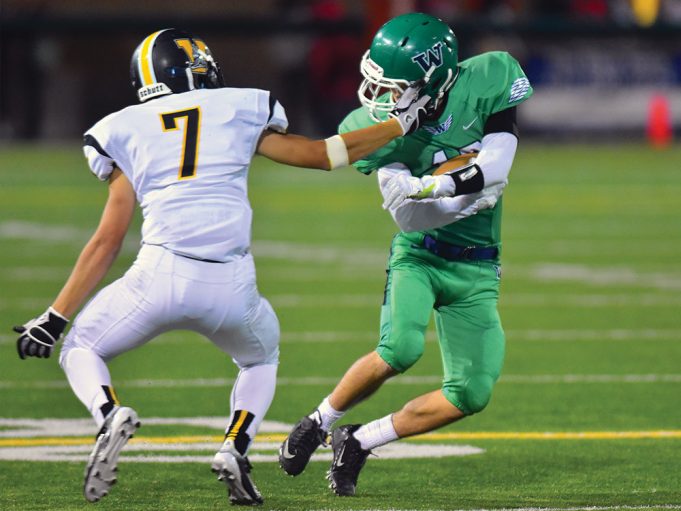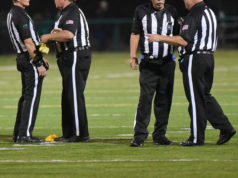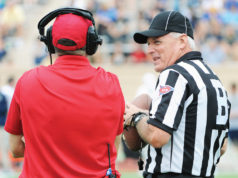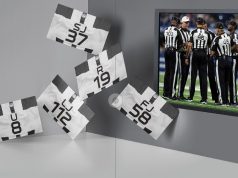No one has ever attempted to rank fouls in the order of the difficulty in calling them. However, it’s clear there is a pecking order. For example, encroachment is easier to call than holding. There are some fouls that are understandably called inconsistently, primarily because it’s often difficult for a single official to see everything that transpired. Holding would be on such a list, but arguably targeting and pass interference would be headliners.
There is another group of fouls that often do not receive a lot of attention, probably because they don’t happen very often. Some officials, who are conscious of advantage/disadvantage, struggle to call these fouls because their impact on the play is seemingly indiscernible. It is no surprise the codes do not agree on these subjects.
Incidental facemask. Although pulling the facemask did not become a foul until several years after helmets were made with facemasks, there is now unanimity on the severe injury that can be caused by a tug or twist on any portion of the helmet. Touching the facemask or the helmet is not a foul. Therein lies the challenge with the NFHS incidental facemask foul, which is the mere grasping of the facemask (9-4-3h Pen.). Did the opponent actually grasp or did he merely touch it? In either case, player safety is not compromised. The NCAA had that foul on the books for a short period and abandoned it, likely because of the difficulty in discerning the foul and the lack of consequences.
Calling that foul should be avoided unless the official is certain there was a grasp and not just a touch. That is very difficult to distinguish during a night game on a typically lit high school field.
Invalid fair catch signal.
There are very specific requirements for a valid fair catch signal. The reality is anything bearing some resemblance to a valid signal is likely to be interpreted as a signal. Players are taught that when a receiver signals, don’t question it and don’t hit him.
A valid fair-catch signal is the extending and lateral waving of one arm at full arm’s length above the head. NFHS specifies at full arm’s length, which is roughly 18 inches above the head. NCAA stipulates more than one wave (NFHS 2-9-3; NCAA 2-8-2). The foul carries a five-yard penalty in NFHS but is not a foul in NCAA.
Very few prep receivers meet the established standard. First, it’s very difficult to wave an arm without bending the elbow and one swing of the arm is technically not a wave. Nonetheless, any movement of the arm with the hand held above the head is going to be interpreted as a fair-catch signal and the covering official should respect it as such.
If the signal is so weak that an opponent doesn’t recognize it and contacts the receiver, the defender’s actions should be excused and the receiving team penalized for the invalid signal.
The most important part of that call is to recognize that once any signal is given, the ball should be whistled dead as soon as any player gets possession. If team K possesses the ball, a different rule applies, but the ball is still dead.
Helping the runner.
For some fouls the illegal act need not be successful. For example, attempting to jump over an upright player is a hurdling foul (the runner in NCAA may legally hurdle an opponent). It does matter whether the player actually makes it over the opponent. In other cases, the intent to commit an illegal act isn’t necessarily a foul. A player who tries to illegally block low and dives at an opponent’s ankles but falls short has not committed an illegal block below the waist.
The helping-the-runner rule is very narrowly written. NFHS prohibits pushing, pulling or lifting the runner, while NCAA prohibits grasping, pulling or lifting. Both require the act “assist forward progress” (NFHS 9-1; NCAA 9-3-2b). Consequently, what may appear to be a helping-the-runner foul will rarely be an actual infraction. First, the rule requires direct contact with the runner, so pushing the pile should probably be overlooked. In NFHS, the “pusher” would have to get his hands on the runner in the pile which is difficult to discern, and in NCAA, pushing the runner is not a foul.
The key to getting that type of play correct is noting the progress of the runner. It is highly likely that if someone is trying to help the runner, his forward progress has been stopped, and the play should simply be whistled dead.
Intentional pass interference.
That foul is unique to NFHS rules (and for good reason the least-called foul of them all). If the previous spot is outside team B’s 45 yardline, it would result in a 30-yard penalty.
Fouls that require an official to determine intent usually incur inconsistency and that’s not a surprise because humans are not mind readers. If a defender who has been beat makes a diving tackle of a receiver who is about to catch a pass, a large majority of officials would judge the act to be intentional. It could happen, but it’s highly unlikely. Anything other than the preceding should simply be pass interference.
Regardless of what position an official works, if he/she can make it through an entire career without having called any of those fouls, he/she can likely still boast that he/she never missed one.
What's Your Call? Leave a Comment:
Note: This article is archival in nature. Rules, interpretations, mechanics, philosophies and other information may or may not be correct for the current year.
This article is the copyright of ©Referee Enterprises, Inc., and may not be republished in whole or in part online, in print or in any capacity without expressed written permission from Referee. The article is made available for educational use by individuals.


















